The Mediating Role of CSR in TQM and Corporate Green Performance
VerifiedAdded on 2023/01/16
|9
|2499
|32
Report
AI Summary
This report examines the relationship between Total Quality Management (TQM), Corporate Social Responsibility (CSR), and Corporate Green Performance (CGP) within manufacturing firms. It explores how TQM practices, such as customer focus, leadership, and strategic planning, can enhance a company's environmental performance by reducing waste and promoting efficient resource utilization. The study highlights the mediating role of CSR, emphasizing how companies can integrate environmental and social concerns into their operations to improve their green practices. The report also discusses the theoretical frameworks of Green Theory, TQM, and the linkage between quality and green performance, demonstrating how these elements contribute to environmental sustainability and financial benefits. The article underscores the importance of bridging the gap in literature by providing insights for management on achieving green development through CSR and TQM, ultimately contributing to a more sustainable and responsible business model. The report also identifies the importance of CGP and its implementation in organizations.
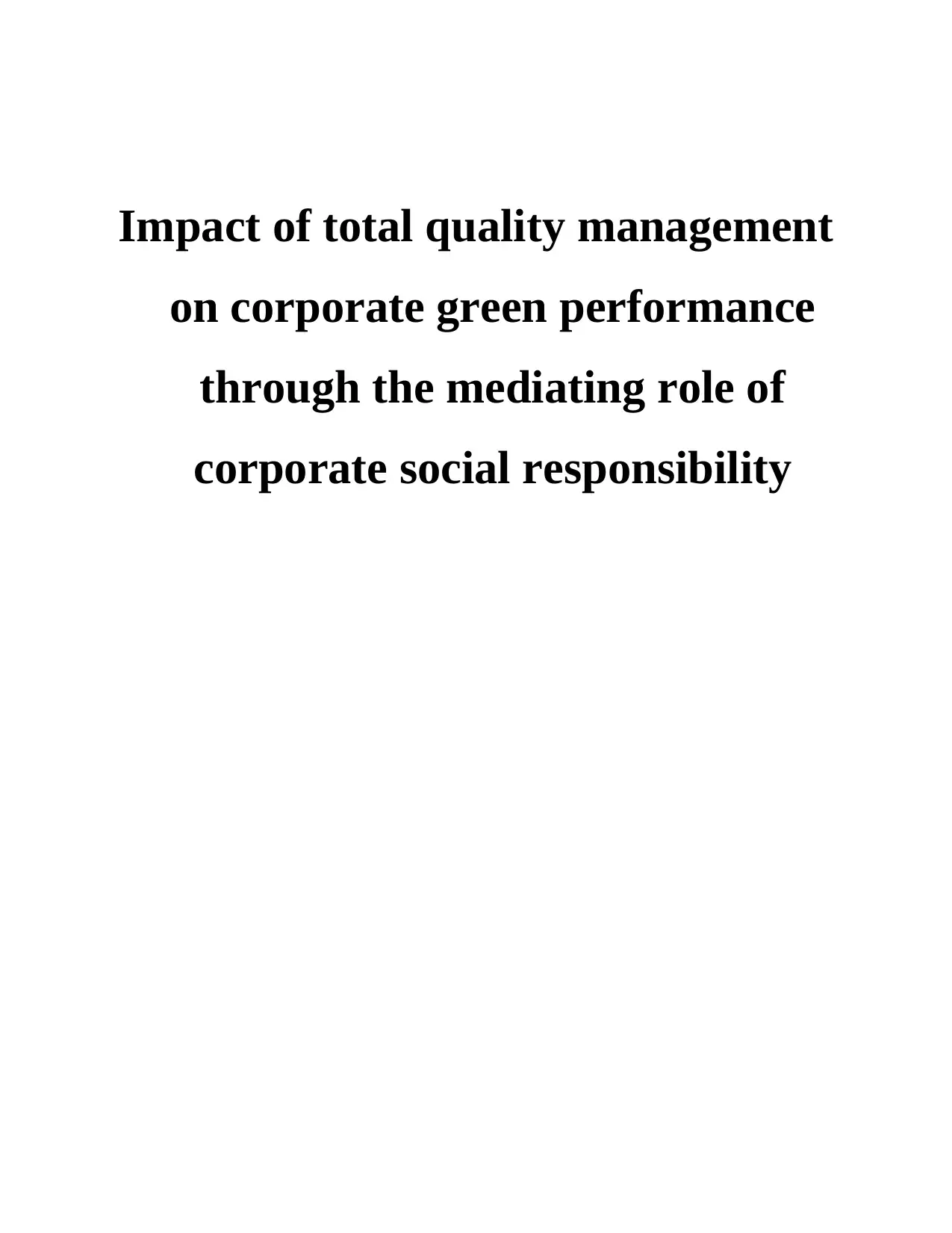
Impact of total quality management
on corporate green performance
through the mediating role of
corporate social responsibility
on corporate green performance
through the mediating role of
corporate social responsibility
Paraphrase This Document
Need a fresh take? Get an instant paraphrase of this document with our AI Paraphraser
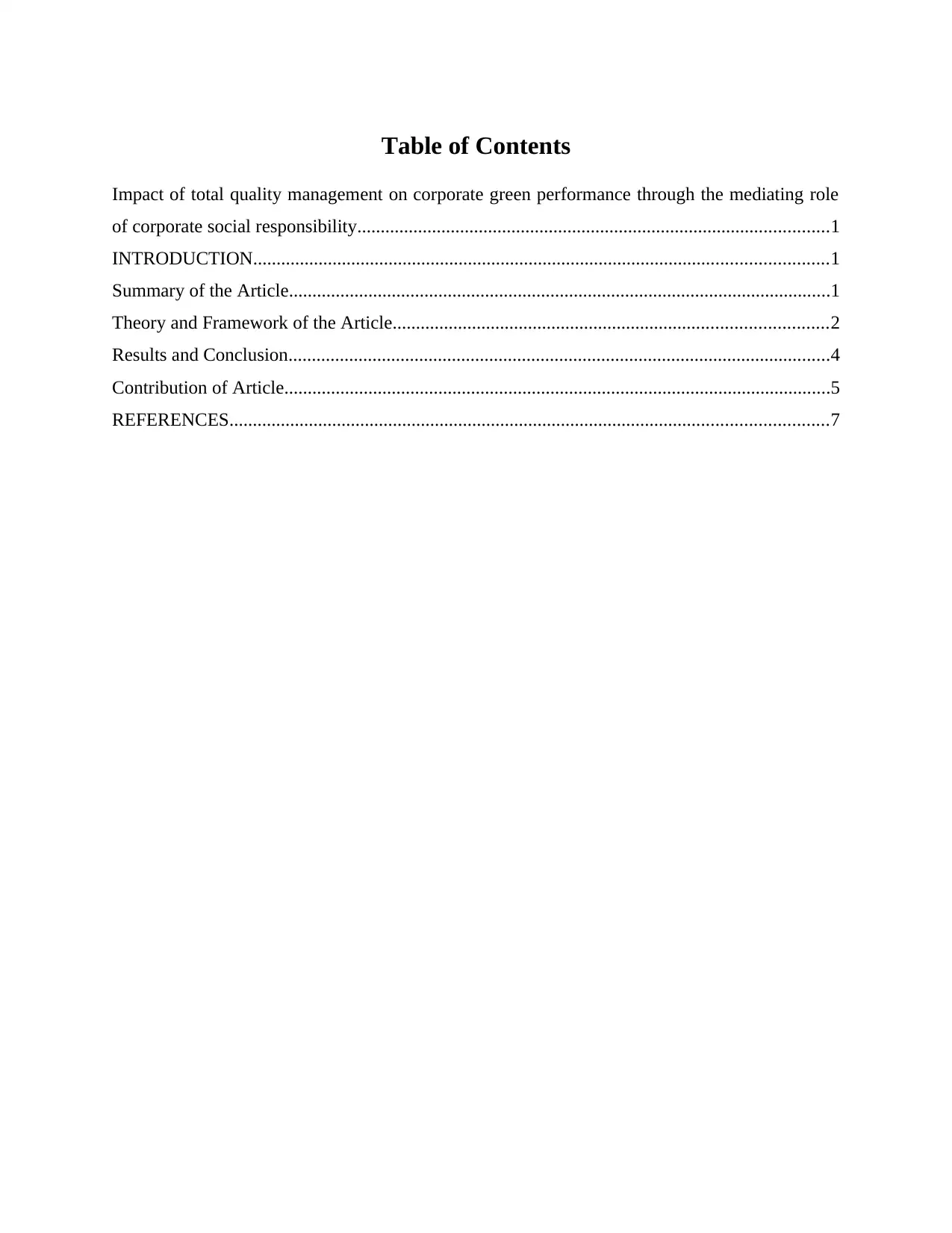
Table of Contents
Impact of total quality management on corporate green performance through the mediating role
of corporate social responsibility.....................................................................................................1
INTRODUCTION...........................................................................................................................1
Summary of the Article....................................................................................................................1
Theory and Framework of the Article.............................................................................................2
Results and Conclusion....................................................................................................................4
Contribution of Article.....................................................................................................................5
REFERENCES................................................................................................................................7
Impact of total quality management on corporate green performance through the mediating role
of corporate social responsibility.....................................................................................................1
INTRODUCTION...........................................................................................................................1
Summary of the Article....................................................................................................................1
Theory and Framework of the Article.............................................................................................2
Results and Conclusion....................................................................................................................4
Contribution of Article.....................................................................................................................5
REFERENCES................................................................................................................................7

INTRODUCTION
Increasing awareness of customers and regulations of national and international
organisations have made it necessary for production firms to counter the issue of increasing air,
soil and water pollutions. Environment have become primary concern for everyone and this
requires that companies focus on environment friendly practices and activities along with their
focus o quality of their product and services. To counter environmental issues Corporate Green
Performance have an important contribution. Corporate green practices refers to practices
employed by companies that are environment friendly and prime consideration behind activities
is to save environment and ensure its sustainability by introducing new and improving old
practices and processes.
Summary of the Article
This article focus on practices of manufacturing firms that contribute to increasing air,
water and soil pollution. This article recognizes pressure of different stakeholders' on firms to
consider impact their operations have on natural environment. This also suggest that firms need
to reduce their dependence on fossil resources that damage to environment and should use
renewable resources. This article recognizes that customers need firms and organisations to focus
on sustainability of environment and their practices for that along with focusing and providing
good quality goods and services. To counter environmental issues of environment corporate
green practices (CGP) have a great potential. CGP means introducing new practices and
improving existing processes so that it does provide quality products as expected by customers
and also result in improved environmental performance. CGP results in Green Product, Green
Practices and Green Management to mitigate challenges and issues activities of production
cause. CGP too link with green innovation that enable firms to deal with environmental
challenges through using technologies for production, assimilation and exploitation of product
and activities of management which reduce environmental issues. Article also suggest and focus
that (TQM) is important factor that can enhance green practices performance. TQM is believed
to be a practice which is friendly to environment that attempt to reduce waste and encourage
effective use of resources that covers natural resources as well. TQM also enhance capability of
individual to innovate and improve existing practices so firm can utilize its resources to its
utmost capability. Corporate Social Responsibility (CSR) is another factor that can help
1
Increasing awareness of customers and regulations of national and international
organisations have made it necessary for production firms to counter the issue of increasing air,
soil and water pollutions. Environment have become primary concern for everyone and this
requires that companies focus on environment friendly practices and activities along with their
focus o quality of their product and services. To counter environmental issues Corporate Green
Performance have an important contribution. Corporate green practices refers to practices
employed by companies that are environment friendly and prime consideration behind activities
is to save environment and ensure its sustainability by introducing new and improving old
practices and processes.
Summary of the Article
This article focus on practices of manufacturing firms that contribute to increasing air,
water and soil pollution. This article recognizes pressure of different stakeholders' on firms to
consider impact their operations have on natural environment. This also suggest that firms need
to reduce their dependence on fossil resources that damage to environment and should use
renewable resources. This article recognizes that customers need firms and organisations to focus
on sustainability of environment and their practices for that along with focusing and providing
good quality goods and services. To counter environmental issues of environment corporate
green practices (CGP) have a great potential. CGP means introducing new practices and
improving existing processes so that it does provide quality products as expected by customers
and also result in improved environmental performance. CGP results in Green Product, Green
Practices and Green Management to mitigate challenges and issues activities of production
cause. CGP too link with green innovation that enable firms to deal with environmental
challenges through using technologies for production, assimilation and exploitation of product
and activities of management which reduce environmental issues. Article also suggest and focus
that (TQM) is important factor that can enhance green practices performance. TQM is believed
to be a practice which is friendly to environment that attempt to reduce waste and encourage
effective use of resources that covers natural resources as well. TQM also enhance capability of
individual to innovate and improve existing practices so firm can utilize its resources to its
utmost capability. Corporate Social Responsibility (CSR) is another factor that can help
1
⊘ This is a preview!⊘
Do you want full access?
Subscribe today to unlock all pages.

Trusted by 1+ million students worldwide

organisation to improve their practices for green performance. CSR is an initiative taken by
Companies and firms to combine environmental and social concerns with the activities of firms.
Companies take initiative to save economic, cultural and social aspect of environment in which
they function their practices of business. Concepts of TQM, CSR and CGP are very similar and
their roots are also same. Article states that firms which are following quality management and
green performance strategies have a good potential to answer to environmental issues. Article
states that implementation of green practices and precesses in companies also require
technological and financial support since it increases time and cost of production. This study also
explain how manufacturing businesses capitalize on their rare resources to achieve objectives of
green practices and how corporate social responsibility mediates this relationship. This article
also states 6 practices of TQM that are, customer focus, leadership, strategic planning, HRM,
process management, and information and analysis. Important focus of this article and study
have been placed on bridging the gap of literature on the relationship in TQM, CSR and CGP
along with providing insights about management of firms to achieve objectives of green
development through CSR and TQM . Theories that have been included in this study for
fulfilling stated objectives are TQM, Green performance and green theory, Linking quality of
operations with green performance and CSR.
Theory and Framework of the Article
Underpinning theories of this article are Green Theory and Green Performance, this
theory states that rate of utilization of resources that are natural by manufacturing industries for
production and making money is high. This has caused shortage of natural resources for future
generations and important change in natural environment, most importantly global warming.
Considering these, organisations like (UNGC) have made it compulsory to follow green
practices and practices that are environment friendly. Ecologist have also urged manufacturing
businesses across world to merge green practices and CSR practices into their functioning. This
not only have a favourable impact on economic condition of organisation but also consider
environment aspect. The objective behind of Green Theory is to achieve sustainability of
environment at all the level. Roots of green performance have been taken from green theory
which represent the link between firms' operations and environment. CGP provides important
information about organisational practices and their follow-up with environment regulations.
2
Companies and firms to combine environmental and social concerns with the activities of firms.
Companies take initiative to save economic, cultural and social aspect of environment in which
they function their practices of business. Concepts of TQM, CSR and CGP are very similar and
their roots are also same. Article states that firms which are following quality management and
green performance strategies have a good potential to answer to environmental issues. Article
states that implementation of green practices and precesses in companies also require
technological and financial support since it increases time and cost of production. This study also
explain how manufacturing businesses capitalize on their rare resources to achieve objectives of
green practices and how corporate social responsibility mediates this relationship. This article
also states 6 practices of TQM that are, customer focus, leadership, strategic planning, HRM,
process management, and information and analysis. Important focus of this article and study
have been placed on bridging the gap of literature on the relationship in TQM, CSR and CGP
along with providing insights about management of firms to achieve objectives of green
development through CSR and TQM . Theories that have been included in this study for
fulfilling stated objectives are TQM, Green performance and green theory, Linking quality of
operations with green performance and CSR.
Theory and Framework of the Article
Underpinning theories of this article are Green Theory and Green Performance, this
theory states that rate of utilization of resources that are natural by manufacturing industries for
production and making money is high. This has caused shortage of natural resources for future
generations and important change in natural environment, most importantly global warming.
Considering these, organisations like (UNGC) have made it compulsory to follow green
practices and practices that are environment friendly. Ecologist have also urged manufacturing
businesses across world to merge green practices and CSR practices into their functioning. This
not only have a favourable impact on economic condition of organisation but also consider
environment aspect. The objective behind of Green Theory is to achieve sustainability of
environment at all the level. Roots of green performance have been taken from green theory
which represent the link between firms' operations and environment. CGP provides important
information about organisational practices and their follow-up with environment regulations.
2
Paraphrase This Document
Need a fresh take? Get an instant paraphrase of this document with our AI Paraphraser
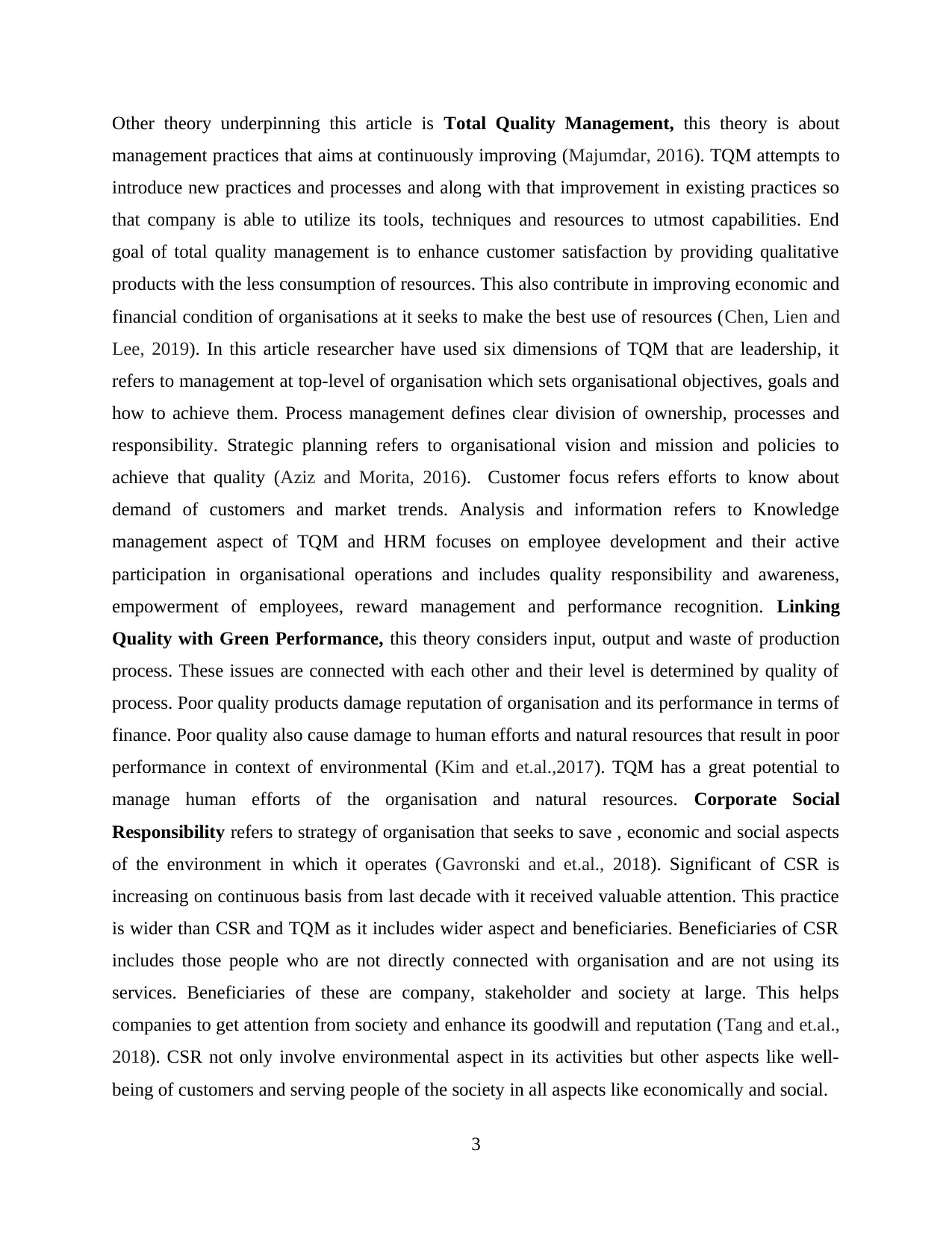
Other theory underpinning this article is Total Quality Management, this theory is about
management practices that aims at continuously improving (Majumdar, 2016). TQM attempts to
introduce new practices and processes and along with that improvement in existing practices so
that company is able to utilize its tools, techniques and resources to utmost capabilities. End
goal of total quality management is to enhance customer satisfaction by providing qualitative
products with the less consumption of resources. This also contribute in improving economic and
financial condition of organisations at it seeks to make the best use of resources (Chen, Lien and
Lee, 2019). In this article researcher have used six dimensions of TQM that are leadership, it
refers to management at top-level of organisation which sets organisational objectives, goals and
how to achieve them. Process management defines clear division of ownership, processes and
responsibility. Strategic planning refers to organisational vision and mission and policies to
achieve that quality (Aziz and Morita, 2016). Customer focus refers efforts to know about
demand of customers and market trends. Analysis and information refers to Knowledge
management aspect of TQM and HRM focuses on employee development and their active
participation in organisational operations and includes quality responsibility and awareness,
empowerment of employees, reward management and performance recognition. Linking
Quality with Green Performance, this theory considers input, output and waste of production
process. These issues are connected with each other and their level is determined by quality of
process. Poor quality products damage reputation of organisation and its performance in terms of
finance. Poor quality also cause damage to human efforts and natural resources that result in poor
performance in context of environmental (Kim and et.al.,2017). TQM has a great potential to
manage human efforts of the organisation and natural resources. Corporate Social
Responsibility refers to strategy of organisation that seeks to save , economic and social aspects
of the environment in which it operates (Gavronski and et.al., 2018). Significant of CSR is
increasing on continuous basis from last decade with it received valuable attention. This practice
is wider than CSR and TQM as it includes wider aspect and beneficiaries. Beneficiaries of CSR
includes those people who are not directly connected with organisation and are not using its
services. Beneficiaries of these are company, stakeholder and society at large. This helps
companies to get attention from society and enhance its goodwill and reputation (Tang and et.al.,
2018). CSR not only involve environmental aspect in its activities but other aspects like well-
being of customers and serving people of the society in all aspects like economically and social.
3
management practices that aims at continuously improving (Majumdar, 2016). TQM attempts to
introduce new practices and processes and along with that improvement in existing practices so
that company is able to utilize its tools, techniques and resources to utmost capabilities. End
goal of total quality management is to enhance customer satisfaction by providing qualitative
products with the less consumption of resources. This also contribute in improving economic and
financial condition of organisations at it seeks to make the best use of resources (Chen, Lien and
Lee, 2019). In this article researcher have used six dimensions of TQM that are leadership, it
refers to management at top-level of organisation which sets organisational objectives, goals and
how to achieve them. Process management defines clear division of ownership, processes and
responsibility. Strategic planning refers to organisational vision and mission and policies to
achieve that quality (Aziz and Morita, 2016). Customer focus refers efforts to know about
demand of customers and market trends. Analysis and information refers to Knowledge
management aspect of TQM and HRM focuses on employee development and their active
participation in organisational operations and includes quality responsibility and awareness,
empowerment of employees, reward management and performance recognition. Linking
Quality with Green Performance, this theory considers input, output and waste of production
process. These issues are connected with each other and their level is determined by quality of
process. Poor quality products damage reputation of organisation and its performance in terms of
finance. Poor quality also cause damage to human efforts and natural resources that result in poor
performance in context of environmental (Kim and et.al.,2017). TQM has a great potential to
manage human efforts of the organisation and natural resources. Corporate Social
Responsibility refers to strategy of organisation that seeks to save , economic and social aspects
of the environment in which it operates (Gavronski and et.al., 2018). Significant of CSR is
increasing on continuous basis from last decade with it received valuable attention. This practice
is wider than CSR and TQM as it includes wider aspect and beneficiaries. Beneficiaries of CSR
includes those people who are not directly connected with organisation and are not using its
services. Beneficiaries of these are company, stakeholder and society at large. This helps
companies to get attention from society and enhance its goodwill and reputation (Tang and et.al.,
2018). CSR not only involve environmental aspect in its activities but other aspects like well-
being of customers and serving people of the society in all aspects like economically and social.
3

Results and Conclusion
On the basis of this report it can be said that environment which has become prime
concern for everyone and manufacturing industries that significantly contribute in damage that
have been caused to environment. This condition and other related factor have generated a need
for manufacturing industries to focus on use of natural resources and sustainability of
environment. For this various theories and practices have been mentioned in this article that
companies can use. Significant consideration is that these practices not only work for
environment protection and sustainability but also have a favourable impact on financial
performance of the company and its reputation. The practices that companies are required to
follow are CSR, TQM and CGP that means Corporate Social Responsibility. Total Quality
Management and Corporate Green Performance respectively. This report have focused on
fulfilling literature gap on relationship between these three aspects. Corporate Social
Responsibility that refers to initiatives taken by companies and their voluntary actions to protect
environment and related aspects like culture, economy etc. All the companies now pay special
attention to this factor, this contributes in improving image and reputation of the company. CSR
can be contributed by TQM which includes best and most efficient utilization of resources that
are available to organisation. For this organisation seeks to introduce new practices or improve
existing practices so that wastage of resources can be reduced, and they can be used more
efficiently. These resources are not only natural resources but human resources as well. To
enhance utility of these resources company need to improve its tools and techniques. Both these
TQM and CSR integrate and contribute to CGP which is Corporate Green performance.
Companies when apply TQM that increase utility of resources and reduces waste of resources
enable organisation to perform green practices which are environment friendly. These practices
are also contributed by CSR, which claim companies for responsible for environment protection
and its sustainability by realizing that their practices are harming and damaging environment. In
this manner all these theories and practices that organisations apply are linked with each other.
Result of this is that companies can consider to have corporate green performance and for that
performance they can apply TQM which will contribute for their green performance which will
then link their performance with their responsibility linking it with CSR. CSR is a mandatory and
wider practice than TQM and corporate green practices. This report have focused on filling the
4
On the basis of this report it can be said that environment which has become prime
concern for everyone and manufacturing industries that significantly contribute in damage that
have been caused to environment. This condition and other related factor have generated a need
for manufacturing industries to focus on use of natural resources and sustainability of
environment. For this various theories and practices have been mentioned in this article that
companies can use. Significant consideration is that these practices not only work for
environment protection and sustainability but also have a favourable impact on financial
performance of the company and its reputation. The practices that companies are required to
follow are CSR, TQM and CGP that means Corporate Social Responsibility. Total Quality
Management and Corporate Green Performance respectively. This report have focused on
fulfilling literature gap on relationship between these three aspects. Corporate Social
Responsibility that refers to initiatives taken by companies and their voluntary actions to protect
environment and related aspects like culture, economy etc. All the companies now pay special
attention to this factor, this contributes in improving image and reputation of the company. CSR
can be contributed by TQM which includes best and most efficient utilization of resources that
are available to organisation. For this organisation seeks to introduce new practices or improve
existing practices so that wastage of resources can be reduced, and they can be used more
efficiently. These resources are not only natural resources but human resources as well. To
enhance utility of these resources company need to improve its tools and techniques. Both these
TQM and CSR integrate and contribute to CGP which is Corporate Green performance.
Companies when apply TQM that increase utility of resources and reduces waste of resources
enable organisation to perform green practices which are environment friendly. These practices
are also contributed by CSR, which claim companies for responsible for environment protection
and its sustainability by realizing that their practices are harming and damaging environment. In
this manner all these theories and practices that organisations apply are linked with each other.
Result of this is that companies can consider to have corporate green performance and for that
performance they can apply TQM which will contribute for their green performance which will
then link their performance with their responsibility linking it with CSR. CSR is a mandatory and
wider practice than TQM and corporate green practices. This report have focused on filling the
4
⊘ This is a preview!⊘
Do you want full access?
Subscribe today to unlock all pages.

Trusted by 1+ million students worldwide
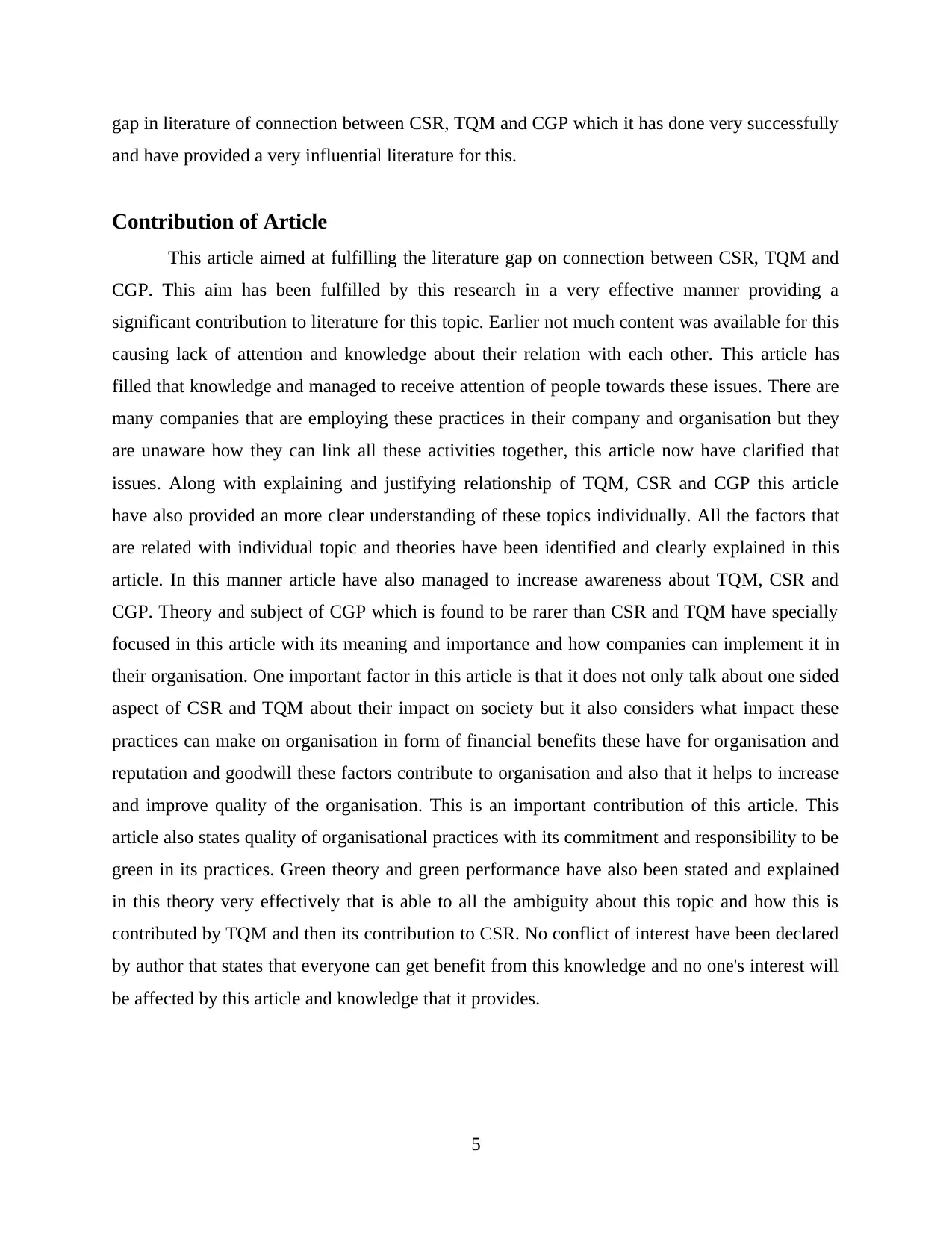
gap in literature of connection between CSR, TQM and CGP which it has done very successfully
and have provided a very influential literature for this.
Contribution of Article
This article aimed at fulfilling the literature gap on connection between CSR, TQM and
CGP. This aim has been fulfilled by this research in a very effective manner providing a
significant contribution to literature for this topic. Earlier not much content was available for this
causing lack of attention and knowledge about their relation with each other. This article has
filled that knowledge and managed to receive attention of people towards these issues. There are
many companies that are employing these practices in their company and organisation but they
are unaware how they can link all these activities together, this article now have clarified that
issues. Along with explaining and justifying relationship of TQM, CSR and CGP this article
have also provided an more clear understanding of these topics individually. All the factors that
are related with individual topic and theories have been identified and clearly explained in this
article. In this manner article have also managed to increase awareness about TQM, CSR and
CGP. Theory and subject of CGP which is found to be rarer than CSR and TQM have specially
focused in this article with its meaning and importance and how companies can implement it in
their organisation. One important factor in this article is that it does not only talk about one sided
aspect of CSR and TQM about their impact on society but it also considers what impact these
practices can make on organisation in form of financial benefits these have for organisation and
reputation and goodwill these factors contribute to organisation and also that it helps to increase
and improve quality of the organisation. This is an important contribution of this article. This
article also states quality of organisational practices with its commitment and responsibility to be
green in its practices. Green theory and green performance have also been stated and explained
in this theory very effectively that is able to all the ambiguity about this topic and how this is
contributed by TQM and then its contribution to CSR. No conflict of interest have been declared
by author that states that everyone can get benefit from this knowledge and no one's interest will
be affected by this article and knowledge that it provides.
5
and have provided a very influential literature for this.
Contribution of Article
This article aimed at fulfilling the literature gap on connection between CSR, TQM and
CGP. This aim has been fulfilled by this research in a very effective manner providing a
significant contribution to literature for this topic. Earlier not much content was available for this
causing lack of attention and knowledge about their relation with each other. This article has
filled that knowledge and managed to receive attention of people towards these issues. There are
many companies that are employing these practices in their company and organisation but they
are unaware how they can link all these activities together, this article now have clarified that
issues. Along with explaining and justifying relationship of TQM, CSR and CGP this article
have also provided an more clear understanding of these topics individually. All the factors that
are related with individual topic and theories have been identified and clearly explained in this
article. In this manner article have also managed to increase awareness about TQM, CSR and
CGP. Theory and subject of CGP which is found to be rarer than CSR and TQM have specially
focused in this article with its meaning and importance and how companies can implement it in
their organisation. One important factor in this article is that it does not only talk about one sided
aspect of CSR and TQM about their impact on society but it also considers what impact these
practices can make on organisation in form of financial benefits these have for organisation and
reputation and goodwill these factors contribute to organisation and also that it helps to increase
and improve quality of the organisation. This is an important contribution of this article. This
article also states quality of organisational practices with its commitment and responsibility to be
green in its practices. Green theory and green performance have also been stated and explained
in this theory very effectively that is able to all the ambiguity about this topic and how this is
contributed by TQM and then its contribution to CSR. No conflict of interest have been declared
by author that states that everyone can get benefit from this knowledge and no one's interest will
be affected by this article and knowledge that it provides.
5
Paraphrase This Document
Need a fresh take? Get an instant paraphrase of this document with our AI Paraphraser

All this are significant contribution that this article have provided. This will specifically
understand and applied by companies and manufacturing organisations to enhance their activities
and then link them with each other.
6
understand and applied by companies and manufacturing organisations to enhance their activities
and then link them with each other.
6
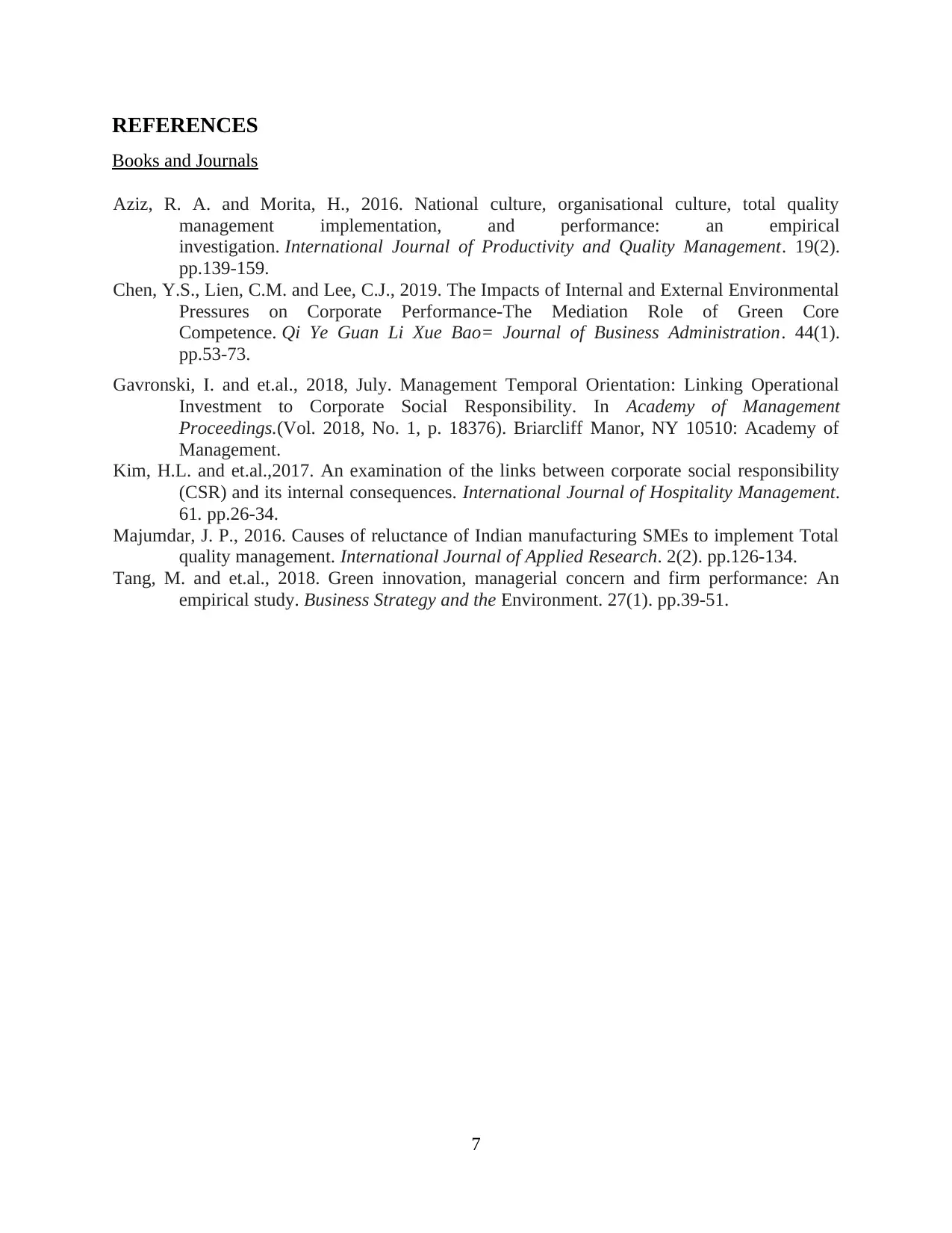
REFERENCES
Books and Journals
Aziz, R. A. and Morita, H., 2016. National culture, organisational culture, total quality
management implementation, and performance: an empirical
investigation. International Journal of Productivity and Quality Management. 19(2).
pp.139-159.
Chen, Y.S., Lien, C.M. and Lee, C.J., 2019. The Impacts of Internal and External Environmental
Pressures on Corporate Performance-The Mediation Role of Green Core
Competence. Qi Ye Guan Li Xue Bao= Journal of Business Administration. 44(1).
pp.53-73.
Gavronski, I. and et.al., 2018, July. Management Temporal Orientation: Linking Operational
Investment to Corporate Social Responsibility. In Academy of Management
Proceedings.(Vol. 2018, No. 1, p. 18376). Briarcliff Manor, NY 10510: Academy of
Management.
Kim, H.L. and et.al.,2017. An examination of the links between corporate social responsibility
(CSR) and its internal consequences. International Journal of Hospitality Management.
61. pp.26-34.
Majumdar, J. P., 2016. Causes of reluctance of Indian manufacturing SMEs to implement Total
quality management. International Journal of Applied Research. 2(2). pp.126-134.
Tang, M. and et.al., 2018. Green innovation, managerial concern and firm performance: An
empirical study. Business Strategy and the Environment. 27(1). pp.39-51.
7
Books and Journals
Aziz, R. A. and Morita, H., 2016. National culture, organisational culture, total quality
management implementation, and performance: an empirical
investigation. International Journal of Productivity and Quality Management. 19(2).
pp.139-159.
Chen, Y.S., Lien, C.M. and Lee, C.J., 2019. The Impacts of Internal and External Environmental
Pressures on Corporate Performance-The Mediation Role of Green Core
Competence. Qi Ye Guan Li Xue Bao= Journal of Business Administration. 44(1).
pp.53-73.
Gavronski, I. and et.al., 2018, July. Management Temporal Orientation: Linking Operational
Investment to Corporate Social Responsibility. In Academy of Management
Proceedings.(Vol. 2018, No. 1, p. 18376). Briarcliff Manor, NY 10510: Academy of
Management.
Kim, H.L. and et.al.,2017. An examination of the links between corporate social responsibility
(CSR) and its internal consequences. International Journal of Hospitality Management.
61. pp.26-34.
Majumdar, J. P., 2016. Causes of reluctance of Indian manufacturing SMEs to implement Total
quality management. International Journal of Applied Research. 2(2). pp.126-134.
Tang, M. and et.al., 2018. Green innovation, managerial concern and firm performance: An
empirical study. Business Strategy and the Environment. 27(1). pp.39-51.
7
⊘ This is a preview!⊘
Do you want full access?
Subscribe today to unlock all pages.

Trusted by 1+ million students worldwide
1 out of 9
Related Documents
Your All-in-One AI-Powered Toolkit for Academic Success.
+13062052269
info@desklib.com
Available 24*7 on WhatsApp / Email
![[object Object]](/_next/static/media/star-bottom.7253800d.svg)
Unlock your academic potential
Copyright © 2020–2025 A2Z Services. All Rights Reserved. Developed and managed by ZUCOL.




